Michael Snow, Mark Lewis and Stan Douglas
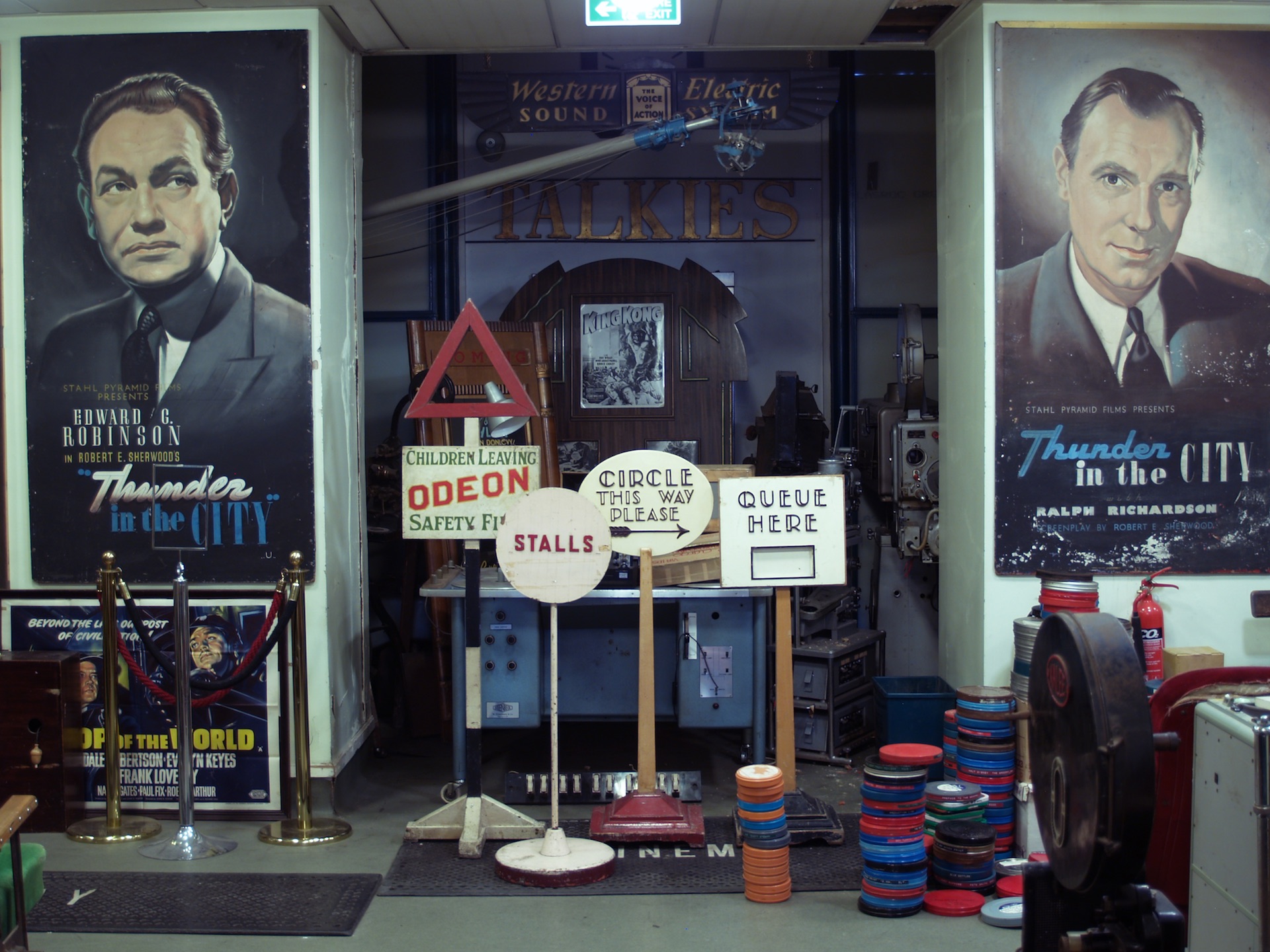
Memories of the Moviehouse
If the word ‘cinema’ has long been associated with an exclusive medium that fixes and freezes images (the reel of film), an appointed room (the movie theatre) and invariable manners of presentation (a single projection for a single screen, in front of which spectators sit in dimmed light, having arrived at the cinema for the film’s start, then leaving it when the film ends), a broader observation of its history renders these same associations incomplete and at times partly erroneous.
Through its proto-history made up of magic lanterns, optical toys, and chrono-photographs; through the countless discoveries scattered among the 1,422 “views” or “shots” filmed by the Lumière brothers and their cameramen—who right away invented a direction style inducing the construction of a narrative through a control of time (dictated by the length of the reel of film) and space (presupposed by framing and depth of field), and who invented the tracking shot, the pan, the first special effects, and the advertising film as well as the family film, the documentary and the fiction film, and even the remake;1 through those experiments called circular projections—including the photorama, brainchild of Louis Lumière again, but also the cinéorama of Raoul Grimoin-Sanson, Abel Gance’s polyvision, and the sound accompaniment provided by musicians, sound effects engineers and barkers; through the various technical developments which have informed it—from the appearance of spoken words (talkies) to that of colour, and from ever larger screens to stereoscopic experiments; through what defines cinema as an “experimental” art, meaning “a practice which questions the medium from top to bottom: its material nature, the conditions in which images are produced, and their organization and linkage (moving away from classical narrative forms), the distribution and screening of movies […] an artistic praxis which is situated at the crossroads of the visual arts and the dominant cinema. Neither one nor the other, but one and the other—i.e. both”:2 in all these ways, the cinema has demonstrated its composite dimension.
Some artists have built their œuvre from this art which lies at the crossing of so many others. Among them, three Canadians: Michael Snow, Mark Lewis and Stan Douglas.
The artist Michael Snow’s œuvre is also composite. Snow (now aged 86) is a film-maker, but he is also a musician. He is a photographer, too, but a visual artist, video-maker and writer as well.
The installation Video Fields (2002-2015) and the film Condensation – A Cove Story (2008), both recently shown by the Martine Aboucaya gallery in Paris, are two disturbing, distinct and nevertheless complementary experiments with and experiences of time and space.
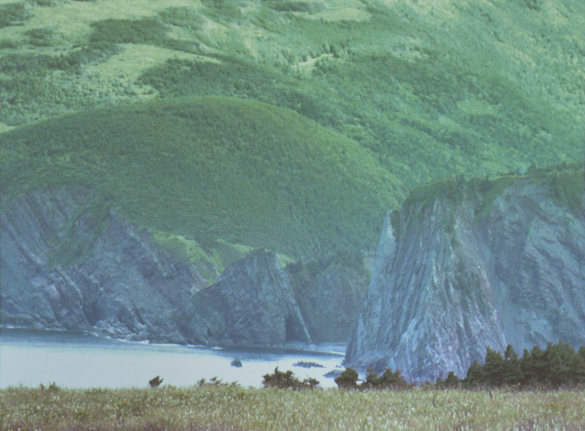
Michael Snow, Condensation – A Cove Story, 2008. Film still. Video 10’28. Courtesy Michael Snow ; galerie Martine Aboucaya, Paris
Condensation – A Cove Story, as its title indicates, is the “condensation” of a recording time: sequences filmed from a single viewpoint, at different moments, then speeded up. The film calls to mind another one titled Cassis, made by Jonas Mekas in 1966, and entirely constructed from images recorded at more or less regular intervals, but at a pace considerably slower than the famous 24 frames/second, well-suited to the creation of the illusion of a fluid and continuous movement. The result is a wonderful discontinuity creating, here too, an effect of acceleration. While Mekas’s camera, fixed to the railing of his friend Jerome Hill’s balcony, occasionally sweeps to left and right with the effect of the wind, Michael Snow’s remains imperturbably static. But it is again to the wind that the film owes the unforeseen nature of its composition, as it is forever renewed: a seaside scene surrounded by cliffs and hills, which winds pushing clouds and mist at times make lighter, at others darker, colouring the whole with endless different shades, some of which become almost monochrome. A landscape leaving the sky out of the picture so that, like the sky’s negative, the shadows of its clouds and the resulting luminous fluctuations become part and parcel of it.
Condensation – A Cove Story is a highly pictorial journey through time, made at a brisk speed. A film which might be the extension of another journey, in praise of the slowness produced 41 years earlier, which the critic Manny Farber described as “The Birth of A Nation in Underground films”: Wavelength, a continuous zoom forward “like a metaphor of time’s arrow and like an inevitable shrinkage of the field of vision”,3 which, from its widest frame to its tightest, moves across a New York loft for 45 minutes, ending up its course in front of a small photo pinned to a wall. This photo represents the surface of the sea, forcing its permanent wave movement into “eternal” motionlessness. The fact is that the angle of the photo’s shot—taken from a slightly high angle—is oddly similar to the frames of Video Fields: an installation repeating the same images—five different fields being swept by the wind, separated from each other by snatched moments of blue sky—simultaneously projected on seven screens. Under the wind’s effect, the continuous quivering and swaying of the tall grasses might be a possible memory of the permanent movement that was removed from the photo of Wavelength.4
The shots of Video Fields, Condensation and Wavelength seem to have been recorded by autonomous machines, whose machinations have been decided upon in advance, separated from the artist’s hand. Which naturally refers to Michael Snow’s most “bachelor” film, La Région centrale, made in 1970-1971. The goal of this film, lasting a little more than three hours, and shot with the help of a camera fixed to a constantly moving machine, was to be “an orchestration of all the possibilities offered by the camera’s movements and of the diversity of the relations between the camera and the object filmed. […] an immense landscape film […] a sort of absolute recording of a wild place”.5 Undoubtedly one of the most extraordinary physical experiences that the seventh art has ever produced. And, paradoxically, this film, which is indeed a Michael Snow film, hook, line and sinker, is also absolutely a film made by a machine.
If, as Godard says in his Histoire(s) du cinema, “a film projector is obliged to remember the camera” 6, then Mark Lewis’s camera remembers countless projections. His films are based on a cinematographic legacy, a “heritage praxis” to borrow Jennifer Verraes’s 7 words, but unlike the use classically made of this by the cinema, each framing, each camera movement, each optical illusion, and each reference to other films is accentuated so as to become a special and unusual perceptual experience, usually stripped of narrative requirements. Otherwise put, precisely where the classical cinema has recourse to what is called cinematographic “grammar” to tell stories, Mark Lewis’s films are perhaps, first and foremost, stories about this grammar.
In 1998 he made a film titled The Pitch, in which he staged himself in a performance-like exercise devised to highlight the role of extras. The film opens with a tightly framed scene, using a high angle shot, focused on the artist who is starting to read a text devoted, it just so happens, to those “silent [proletarians] of film studios”.8 A slow zoom backwards helps us to grasp the surrounding space: a railway station filled with lots of travellers. Through this arrangement, anyone entering the camera’s field potentially turns into an extra, including the artist, the film’s only “actor”, who is soon drowned in the throng. Except that, here, being an extra does not mean complying with narrative circumstances, it is tantamount to inhabiting a space: an incredible summary of what framing means in film. And all it took was a four-minute sequence shot, the length of the 35 mm. reel, a period acting like a constraint and conceived “for someone seeing the film in a gallery.”9 A painstaking labour involving space and time, which North Circular materializes two years later through a gradual forward tracking shot, in the direction of a ruined building, behind whose broken windows a teenager is playing with a spinning top, and when the top stops spinning, that is the end of the film. Like the top, Mark Lewis’s films depict the fragile balance between a movement and its development in time. Usually in total silence. Sometimes the equilibrium calls for a total rotation of the camera on its own axis, which makes the image pivot 360o (Harper Road, 2003). At other times, it is the static shot of a mist-shrouded landscape with glimpses of an island and a small boat (Algonquin Park, September, 2001), bestirring memories of a famous painting by Böcklin. At other times, still, the image is turned inside out—“topsy turvy”—in such a way that the passers-by treading London’s pavements in Rush Hour, Morning and Evening, Cheapside, at dawn and at sunset, become shadows which take precedence over the bodies giving rise to them.
Film after film, the camera movements increase in number, as, for example, in Forte (2010), a dizzy-making plunging view over an Alpine valley, and again in Above and Below the Minhocão(2014), where a freeway, devoid of vehicles but filled with strollers, is filmed as if in a state of weightlessness, in the day’s dying light, a kind of “archaeological vestige of modernity”, to use the auteur’s words.
The centre of gravity of Mark Lewis’s work might have occurred in 2008, when he decided to film a guided visit to a film museum for 36 minutes, using a steadycam, and sequence shots. Over film libraries he prefers the private collection of compulsive film buffs, Ronald Grant and Martin Humphries, made up of bits and bobs, “with its piles of objects which are by turns old-fashioned, expired or fragmentary”, an “accumulation of obsolete things separated from the time when they had the ‘life of an object’, which is to say a function, or a topical sense.”10 A museum which rather conjures up an attic or a cellar, those places where, among the clutter of old things, incalculable treasures often lurk. A confirmation of the artist’s interest in what defines the cinema in its wings. Unlike most of the other films, Cinema Museum seems intent on telling a story, at least that of the museum and its exhibits. But the narrative only surfaces very briefly and is then lost in the labyrinthine space drawn by the camera in the midst of the different rooms and numerous corridors, in front of the countless objects it comes upon, confirming their passage in time.

Mark Lewis, Snow Storm at Robarts Library, 2015. Film still. Courtesy Mark Lewis ; Daniel Faria, Toronto ; Marcelle Alix, Paris. © Mark Lewis.
Screened for the first time outside Canada at the Marcelle Alix gallery in Paris, Snow Storm at Robarts Library, one of the artist’s latest productions, seems to condense the work’s wide span into barely eleven minutes. Everything starts with a slow pan, showing the city of Toronto from left to right, in wide-angled shots and in black and white. An introduction to the subject which is in no time upset by one or two details: in this cityscape, no smoke escapes from the few chimneys visible in the distance, rather it enters them, or, more precisely, returns into them; vehicles do not move forward, they all move in reverse. When the camera reaches the end of its wide angle shot, it advances towards a building with modern, angular architecture11 and then miraculously passes through a glass window behind which a young woman, standing, is leafing through a book made up of pictures of the Sienese School, confirming in passing the artist’s interest in painting and its history. And colour replaces the black and white. And the city, now observed from inside the building, has once again become subject to the laws of time: the vehicles move forward, as do the pedestrians…
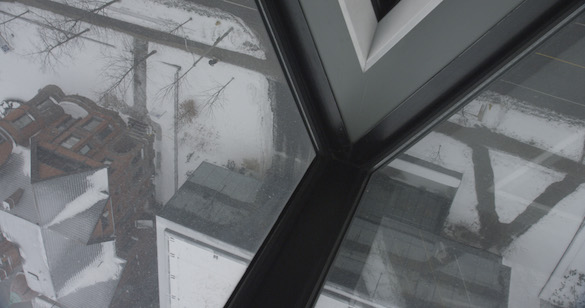
Mark Lewis, Snow Storm at Robarts Library, 2015. Film still. Courtesy Mark Lewis ; Daniel Faria, Toronto ; Marcelle Alix, Paris. © Mark Lewis.
The more the work progresses, the more Mark Lewis’s camera seems to be saying: “Me, machine, I’m showing you the world in the only way I can see it. I am freed from human immobility, I’m in uninterrupted motion”.12 De-anthropomorphized, it increasingly reminds us of the machine in Michael Snow’s La Région centrale.13 And as its movements become more complicated, among the countless projections it remembers, there also seem to be projections of Mark Lewis’s films. A loop come full circle, in a way.
If cinematographic grammar is one of the challenges of Stan Douglas’s work, unlike in the case of Mark Lewis, what concerns the Vancouver-based artist above all are narrative possibilities.
The cinema, or rather the kinetograph, was summoned in his first installation, Ouverture (1986), taken from old Edison movies, accompanied, in the voice-over form, by a reading of excerpts from Marcel Proust’s In Search of Lost Time. A plunge into history, time and, de facto, memory. But also an exercise in appropriation which was backed up by the ensuing works. In 1987, with his TV Spots, “he turned the imagination requisitioned by the advertising film against this latter”.14 With his Monodramas, he hijacked the narrative constructs of television series. An operation that he repeated by way of the double projection of Win, Place or Show (1998), a quarrel between two men, in an apartment, filmed from different angles.
An approach which consists in playing “on the basis of cinematographic topoi […] with arrangements of filmed sequences on several screens […], thus re-inventing, within the exhibition space, the time-based logical systems of film montage (the shot-reverse shot and the sequences of viewpoints, henceforth exposed and rendered simultaneous on wall-screens).”15
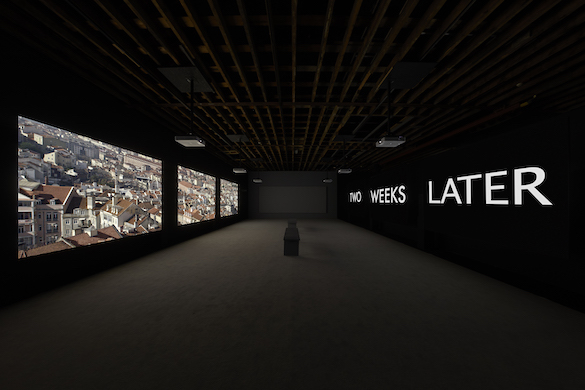
Stan Douglas, « The Secret Agent », Victoria Miro, London, 02.02–24.03.2016. Courtesy Stan Douglas ; David Zwirner, New York / London ; Victoria Miro, London. Photo : Robert Glowacki. © Stan Douglas
In 1995, he made The Sandman, probably the crux of his œuvre. Der Sandmann was first of all a novel written by E.T.A. Hoffmann in 1817, before serving as an example of the concept of uncanniness developed in 1919 by Sigmund Freud. What is less well known is that Freud had previously had a deep interest in another text, Memoirs of My Nervous Illness, written by a certain Daniel Paul Schreber, the son of the physicist Moritz Schreber, inventor of repressive educational methods and, in the mid-19th century, founder of the Schrebergärten, which were kinds of German allotments.
The installation consisted in two contiguous projections of two sequences—two pan shots—filmed in exactly the same spot, in the old Babelsberg studios, the selfsame studios which saw the birth of German cinema between the wars. A character reads a text inspired by the Hoffmann novel, and other voice-over readings respond to this. The camera films inside a studio as well as in a Schrebergärten, re-created for the occasion. If one of the sequences is meant to be contemporary, the other represents the past. Douglas said that he had wanted to “create a sort of temporal polyphony, making it possible to simultaneously perceive two different things.” So the images, which are similar but not altogether identical, create this sensation, which is described in Freud’s writing: something which becomes strange—uncanny—through its very repetition.
Adapting a literary opus and upsetting its narrative linearity, creating a clash between different time-frames, and piling historical layers one on top of the other, all these are still components of the installation titled The Secret Agent, made in 2015, and recently shown at the Wiels contemporary art centre, in Brussels, as well as at the Victoria Miro gallery in London. In the obscurity of a room, six screens, arrayed in two rows of three and set opposite each other, split up a tale of espionage, against a backdrop of politics, conspiracies and murder. The Secret Agent is the adaptation of a Joseph Conrad novel of the same title. The novel’s political context—early 20th century London— is transposed to Lisbon, in 1975, the year following the military coup d’état which toppled the authoritarian Estado Novo regime, headed by Antonio Salazar since 1932. The treachery described in the original text helps readers not only to question the political and social upheaval which shook Portugal in 1975, but also to see in that upheaval a sign of History’s possible faltering.
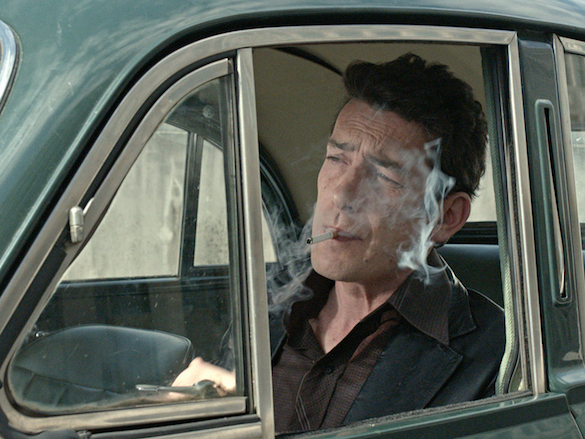
Stan Douglas, The Secret Agent, 2015. Film still. Courtesy Stan Douglas ; David Zwirner, New York / London ; Victoria Miro, London. © Stan Douglas
One of the novel’s main settings is a bookshop which Stan Douglas turned into a cinema, filmed from its foyer right into the wings of the projection room. Of the projection itself there remains no trace, apart from one or two reflections, and a poster which surveys the entrance. Isn’t this off-screen arrangement noteworthy? The film projected, whose poster tells us that the work in question is Last Tango in Paris, is not only a reference to the history of the cinema, but also like a parallel spectacle to the one staged by the artist. As if The Secret Agent and Bertolucci’s movie inhabited the same “Moviehouse”. Maybe not the same room, and perhaps not the same floor… Somewhere in the house, a photo depicting the sea’s surface is pinned up. Somewhere else, a teenager is playing with a spinning top. Workers employed in the Lumière factories spill out of a door, while another door opens onto a magic lantern spectacle.

Stan Douglas, The Secret Agent, 2015. Film still. Courtesy Stan Douglas ; David Zwirner, New York / London ; Victoria Miro, London. © Stan Douglas
1 Three versions of La sortie d’usine – the very first movie in film history—were made.
2 Yann Beauvais, “Démonter le cinema”, Art Press n° 262, November 2000, p. 42.
3 Françoise Parfait, Vidéo : un art contemporain, Éditions du Regard, 2001, p. 67.
4 The installation also includes a monitor broadcasting the image of the synthesizer which was used to compose the sound track, similar to the noise of the wind.
5 Michael Snow, La Région centrale (1969), in Michael Snow, Des écrits 1958-2001, Centre Pompidou, 2002, p. 31.
6 Jean-Luc Godard, Histoire(s) du cinéma, Chapitre 1(b), Seul le cinéma, Gallimard, 1998, p. 192.
7 Jennifer Verraes, “Economies du référent 4. La fausse monnaie. Two impossible films (Mark Lewis 1995-1997)”, Cinéma & Cie-International Film Studies Journal, n°10: Cinema and contemporary visual art II, Spring 2008, p. 55.
8 Mark Lewis, The Pitch (1998), in Mark Lewis, Above and Below, Le Bal, 2015, p. 6.
9 Mark Lewis, interview with Anne-Claire Meffre as part of the exhibition “Above and Below”, Le Bal, Paris, 2015.
10 Barbara Le Maître, “Invincible dialogue des résurrections”, in Cinéma muséum, Presses Universitaires de Vincennes, 2013, p. 16.
11 The Robarts Library in the title is the main university library in Toronto.
12 Dziga Vertov, “Résolution du Conseil des trois du 10 avril 1923”, in D. Vertov, Articles, Journaux, Projets, Paris, Cahiers du cinéma-10/18, 1972, p. 30-31.
13 Chantal Pontbriand incidentally suggests that “the artist will leave the leading role to the camera. As in Samuel Beckett’s film, Film, the camera will examine the possibilities offered by the moving image” in Mark Lewis, Above and Below, Le Bal, 2015, p. 277.
14 Françoise Parfait, Vidéo : un art contemporain, op.cit., p. 265.
15 Philippe Dubois, La question vidéo, Yellow Now, p. 110.
Related articles
Biennale Son
by Guillaume Lasserre
Lou Masduraud
by Vanessa Morisset
Bharti Kher
by Sarah Matia Pasqualetti
